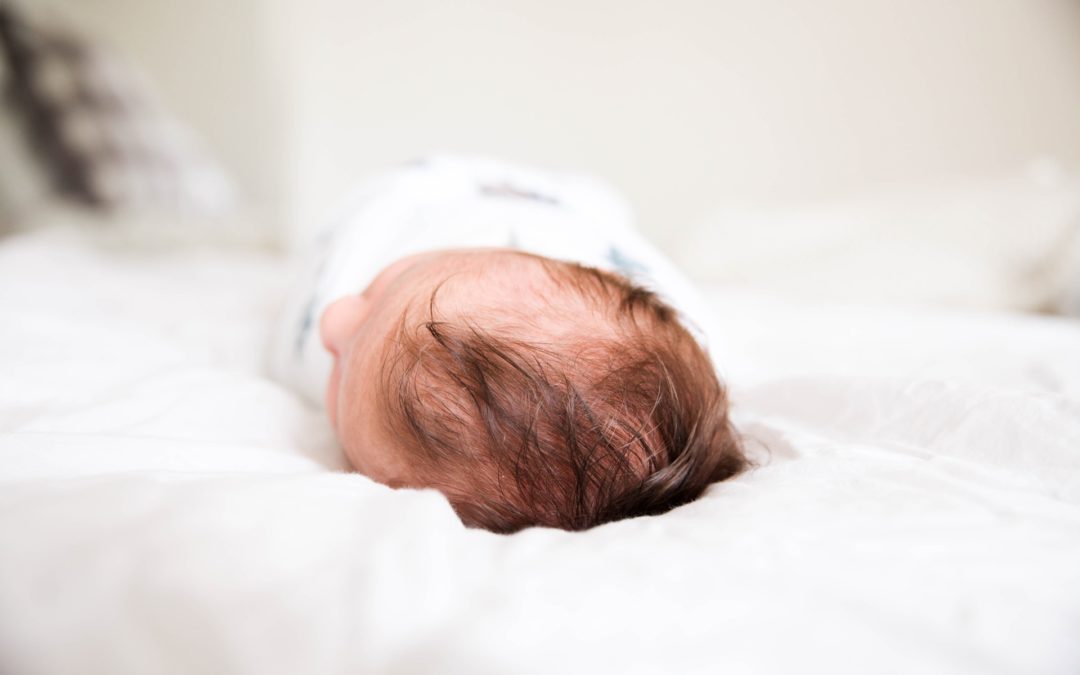Dirty diapers? Yes. Sleepless nights? Of course. A pimply, pointy-headed newborn—what’s up with that? Let us clue you in on the biggest surprises about little babies.
My baby’s head looks strange
You envisioned a picture-perfect Gerber baby—round, rosy, and oh-so-cute. If your newborn’s head looks a little strange and cone-shaped at first, that’s because he probably spent hours wedged in your pelvis. Openings in the skull allow it to mold its shape to fit through the birth canal. “This protects against skull fractures or brain injury during a vaginal delivery,” says Anne Hansen, M.D., a neonatologist at Children’s Hospital Boston and an assistant professor of pediatrics at Harvard Medical School.
Other imperfections add to your baby’s temporary troll-like appearance. If he slid out on his nose, his nostrils may be a bit squashed. Fluids accumulated under his skin may make his eyes look swollen. And he may even have a few small bruises on his face and scalp if forceps or a vacuum extractor was used to deliver him. Your baby is a work of beauty in progress. Be patient, and he’ll soon become the angel you imagined.
My baby’s so jumpy.
After spending months curled up in a bag of water inside a cozy, snug womb, your newborn now has all the space in the world to move, with no restrictions on her limbs. She hasn’t quite figured out how to control her body in this new medium, so a small wave of her arm becomes a wide jerky swing. Babies are also born with the Moro, or startle, reflex: When your infant senses she’s falling or is startled, she’ll suddenly throw out her arms, open her hands, draw her head back, and then quickly bring her arms back in. This reflex disappears by 3 months. A still-developing neurological system also sends more electrical impulses to muscles than necessary, which can cause your baby’s chin to quiver or legs to tremble. As things become more organized over the first couple of weeks, she’ll tend to shake less. Most quivers are nothing to worry about, but see a doctor if your baby’s shaking is rhythmic or if a trembling limb doesn’t stop when you touch it.
My boy’s so big down there!
Before your husband takes credit for your newborn son’s huge testicles, he should know that neither genetics nor super-powered male hormones played any part in their size. The swelling is actually a result of pressure exerted on your baby during birth, as well as by fluids trapped in tissue. Also, all new babies still have Mom’s hormones circulating in their body. In boys, these hormones enlarge the testicles; in girls, they cause the labia to swell. Genital swelling subsides over the first couple of days.
My baby’s always hungry.
In the first weeks, it might feel as if you’re feeding your infant around the clock. Her frequent demands are nature’s way of increasing your milk supply to meet her growing appetite. Breast-fed babies also tend to eat more frequently, because breast milk is more quickly digested and more completely absorbed than formula.
The reason for the feeding frenzy, of course, is that your little one has a lot of growing to do. She’ll double her birth weight in six months, which requires a huge caloric intake. Expect your baby to be particularly ravenous during growth spurts; the first typically occurs between 4 and 6 weeks of age. Just be careful that you don’t misinterpret her cues as hunger when all she may want is comfort or closeness, says ob-gyn Glade Curtis, M.D., author of Your Baby’s First Year Week by Week (Fisher Books, 2000). If she has eaten within the last two or three hours, try holding and swaddling her to see if that calms her down.
My baby’s hands and feet are cold.
Before you crank up the thermostat or wrap your little one in another blanket, feel his torso. If it’s warm and pink, your baby isn’t chilled. Because his circulatory system is still developing, blood is shunted more often to vital organs and systems, where it’s needed most. His hands and feet are the last body parts to get a good blood supply. It can take up to three months for his circulation to adapt completely to life outside the womb. In the meantime, it’s common for his tiny fingers and toes to feel chilly and look pale. As your baby becomes more mobile and active, his circulation will improve.
My baby has blood in her diaper.
The same maternal hormones that cause swollen testicles and labia are also responsible for the bloody vaginal discharge that newborn girls sometimes have. Don’t worry if you see a small smudge of blood or bit of staining on your baby’s diaper in the first weeks of life. This mini menstrual period usually lasts only a few days, Dr. Curtis says. Sometimes, what looks like blood may actually be concentrated urine, which can look quite dark in the folds of a diaper. Bright red blood, however, is unusual and warrants medical attention.
My baby has a blister on his lips.
Many newborns develop a nursing tubercle or blister from vigorous sucking on a bottle or breast. In some cases, the blister is present at birth because of thumb-sucking in the womb. A sucking callus causes no discomfort to your baby. In fact, the overgrowth of skin stiffens the lip and may make grasping the nipple easier. The callus will disappear on its own in a few months, or it might come and go from day to day.
My baby’s poop looks like diarrhea.
Breast-fed babies have seedy, mustard-yellow stools that are liquid and unformed, while bottle-fed infants tend to have slightly more solid bowel movements with a brownish color and the consistency of soft ice cream. Some babies poop a dozen times a day, while others pass stools just a few times a week. As long as your child is gaining weight and has no abdominal pain or bloating, her pooping frequency is fine.
It can be hard to distinguish normal bowel movements from diarrhea, particularly if you’re nursing. Breast-fed babies commonly poop after every feeding. (It’s called the gastro-colic reflex: Whenever milk goes into the stomach, something comes out the other end.) And their stools are naturally looser. Your best bet is to become familiar with what’s usual for your baby. If the frequency, volume, or consistency changes dramatically, see your doctor.
My baby sneezes all the time.
Newborns sneeze a lot, but not because they’re cold or sick. It’s simply how they clear their nasal and respiratory passages of congestion and airborne particles. Sneezing also helps reopen a temporarily closed nostril. “When a mom nurses and her baby is pressed up against her, his nose might be flattened or one nostril pushed shut,” Dr. Curtis says. “After feeding, the baby will take a breath or sneeze to open his nose again.”
My baby’s skin is flaky.
While your baby was bathing in a lagoon of amniotic fluid, his skin was nicely protected from the watery environment by a coating of white, waxy material called vernix. But once he’s exposed to the air and the vernix is rubbed away, the upper layer of his skin dries out and begins to peel. Your child’s entire body may peel (although it’s most noticeable on the hands and feet). Don’t try to pick off the flakes — you might remove skin that’s not ready to be shed. Moisturizers aren’t necessary either. The flaking usually lasts one to two weeks.
My baby is breathing strangely.
Like many new parents, you probably spend a good part of each night bent over the side of your little one’s crib, checking to make sure she’s still breathing. And you’ve probably been freaked out a few times watching her irregular breaths. But it’s actually normal for infants to take slight pauses and then go through periods of rapid breathing. “Occasionally catching or skipping a breath is part of the development of the diaphragm [the muscle that enables breathing] and neurological system,” Dr. Curtis says. A pause of up to 20 seconds is considered normal. By the time she’s about 6 weeks old, your baby should develop a more regular pattern of breathing.
You worry about SIDS, of course, and you’re wise to be vigilant. Put your baby to sleep on her back, keep all soft bedding and toys out of her crib, and don’t smoke. If your baby ever stops breathing for longer than 20 seconds (a sign of apnea) or turns blue or limp, seek medical attention.
My baby’s cries all sound the same.
You’ve heard how moms are supposed to know instinctively whether their baby’s hungry, tired, or in need of a diaper change just from the sound of his cry. But if you’re still not fluent in your baby’s first language, don’t worry. “Over time, you’ll recognize the loud shrieking of the pain cry and the more subdued whimpering of fatigue,” Dr. Hansen says. The hunger cry usually falls somewhere in between, although some babies can sound pretty desperate (and loud) when they want to be fed right away. But in the early days, it doesn’t really matter why your little one cries (sometimes he’ll howl for no reason at all). You’ll still react with the same loving attention each time — and that’s all your baby really wants or needs.
All content, including medical opinion and any other health-related information, is for informational purposes only and should not be considered to be a specific diagnosis or treatment plan for any individual situation. Use of this site and the information contained herein does not create a doctor-patient relationship. Always seek the direct advice of your own doctor in connection with any questions or issues you may have regarding your own health or the health of others.
We couldn’t have said it better, that is why this is a direct repost from Parents


